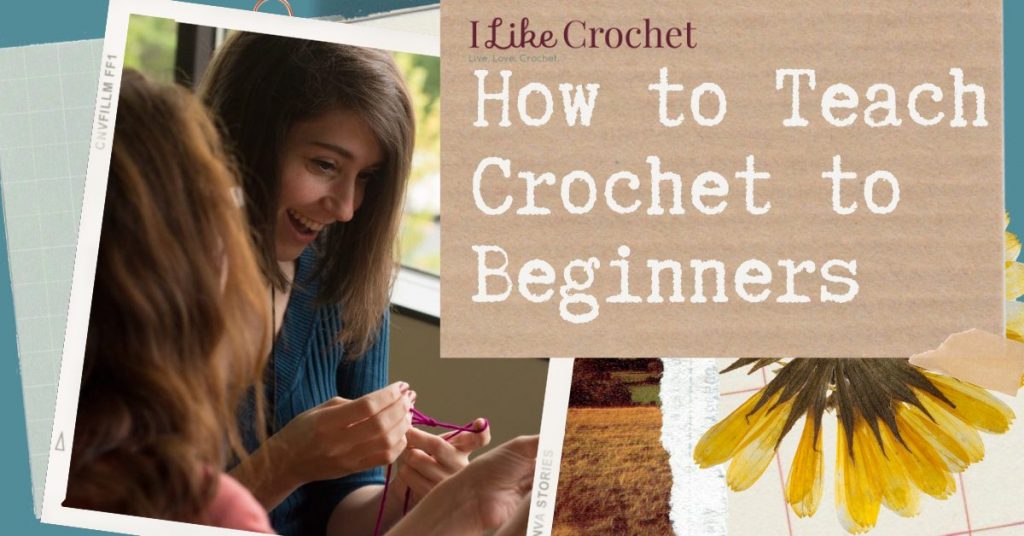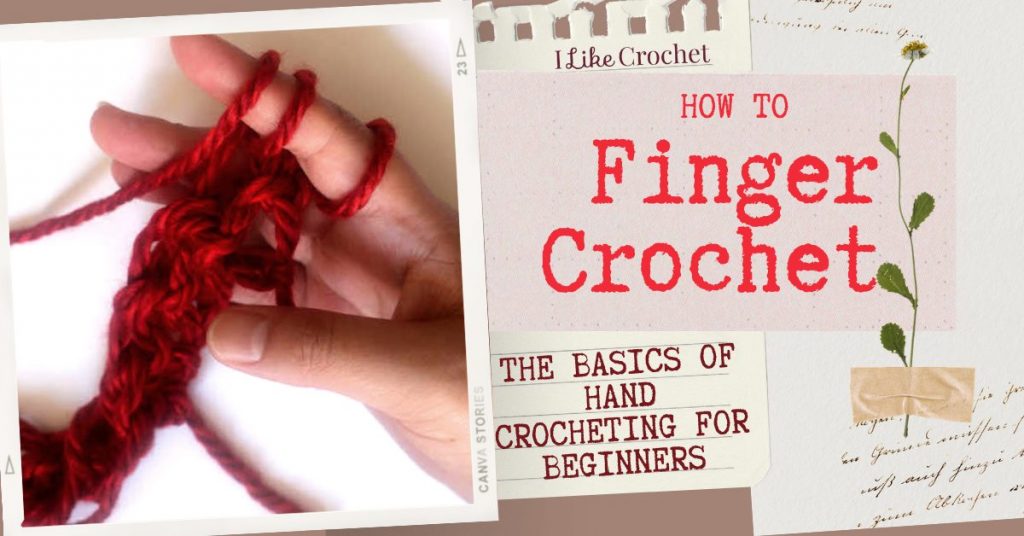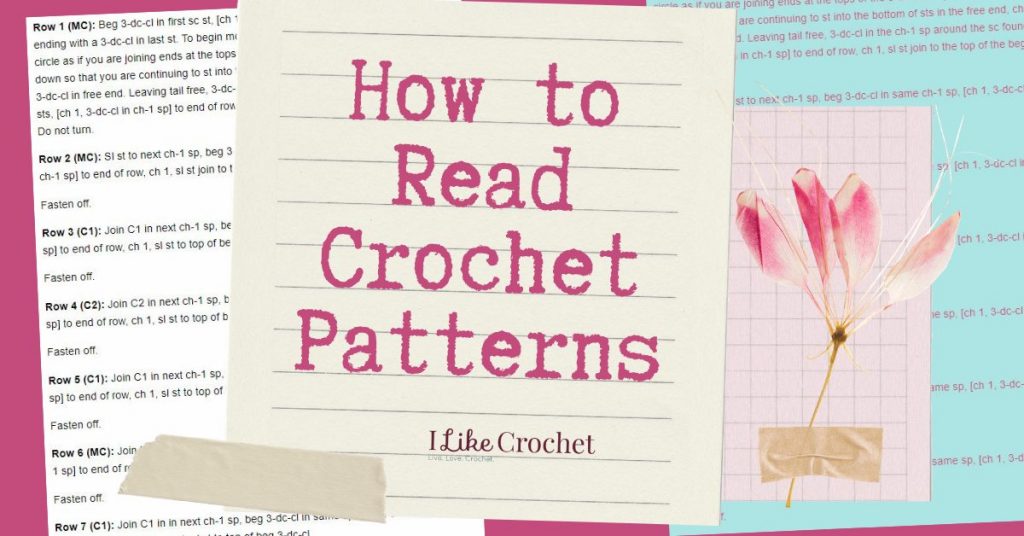
Teaching crochet doesn’t have to be intimidating! While teaching is a skill in itself that takes practice and refining—just ask any teacher—you can learn some basic tips and tricks for for how to teach crochet to beginners (and teaching in general) so your loved ones can learn a skill near and dear to your heart.
14 Steps for Teaching Crochet
- Create a basic lesson plan. I suggest teaching ch, sc, and if there’s time, dc. You’ll also want to teach finishing and weaving in ends. If you only get to single crochets, that’s totally fine! However, if your student masters double crochet as well, this opens up an entire world of intermediate crochet stitches that are usually made up of some combination of these basic stitches, anyway! Note: Bear in mind all of the individual skills you’ll have to teach. Not only are you teaching the mechanics of a single crochet stitch, but how to end a row, chain, turn, etc.
- Leave room to improvise. Expect that teaching the slipknot will take you longer than expected (trust me). People are going to struggle with holding the hook, with tension and with holding the yarn. Their yarn tail is going to flail all over the place. They will have a hard time determining exactly where to place their hook. Be patient and expect the basics to take time.
- Watch videos to see how other crocheters teach. I found this step to be invaluable. While you can probably do a slipknot without even thinking about it at this point, your students might really struggle to grasp the new concept.
There are several ways to teach how to do a slipknot. Look online for some inspiration and also examine your own fingers closely as you make a slipknot. How can you explain to your student exactly what you’re doing? Think about this ahead of time and class will flow more seamlessly. - Determine the size of your group. Are you teaching just one friend, a few close friends, a group of ten coworkers or a birthday party? Each group size has different requirements. You want the ratio of instructors to students to be as small as possible. For example, when we held knitting and crochet classes in our office in the fall of 2016, about twenty people signed up to participate. That is way too many students for one teacher! We had five people teaching the class, so the teacher-student ratio was 1:4.
- Determine your time frame. I found that two hours was a really comfortable amount of time to dig in without the students getting overwhelmed and it allowed plenty of time to practice.
- Visual aids don’t hurt. I once attended a knitting class where the instructor printed out images and the basic stitch pattern for several common knit stitches like stockinette, garter stitch, and ribbing. Printing a visual aid of the different basic crochet stitches (chain, single crochet, double crochet, half double crochet, and even treble crochet) would be a wonderful resource for your student to take home after you’ve spent the afternoon together.
- Bring completed projects to class. Another example of a visual aid is showing your student(s) projects you’ve made before! These can (and should) range in experience level from basic to advanced. Inspire your students by showing them a simple single crochet swatch they could make themselves by the end of class and an advanced lace doily (this is what they’ll be able to achieve after some practice).
- Slow down. It’s easy to get into the rhythm of things and go at a normal pace, but your student is going to need to you go slow so they can learn. Similarly, repeat each skill multiple times together to better grasp it. Don’t assume your student was able to follow you perfectly after you showed them something once. Repetition is key when it comes to teaching crochet.
- Understand that your method might differ from your student’s. Make sure you research a few different ways to hold your crochet hook and yarn, for example. There is the knife grip and pencil grip for holding your hook and when it comes to holding your yarn, there are tons of different ways to hold it while maintaining tension (although I wouldn’t worry about tension when teaching this beginner class). Some people loop the working yarn around their pinky finger, others hold it near their middle or pointer fingers. Allow your student to hold the yarn and hook in whatever way makes sense to them, offering guidance if and when asked.
- Look at the finished product, then examine the process. On a similar note to above, don’t get caught up in the differences between your crochet method and how your student crochets. If their single crochets look like single crochets, it doesn’t matter if they held their yarn a little differently to get the same effect!
- Explain the WHY whenever possible. Telling your student that you chain one at the end of a single crochet row to account for the height of the next row will help them remember the importance of this step. Seize any other opportunities possible to explain the why. Something I like to tell students as a fun fact is comparing knitting to crochet: knitting is like weaving, while crochet is like tying knots. Background information can aid in understanding.
- Give tons of encouragement! They say that for every piece of criticism you give, you should offer five pieces of praise. This applies in the business setting and in the teaching setting as well! It’s easy for new crocheters to feel discouraged ¾ just think back to when you first learned ¾ so be sure to remind them that it is a challenging craft to learn, but they can do it!
- Leave time for a break. If a class lasts more than an hour, a break to refresh and reset is definitely a good idea. If you’re having the girls over to learn crochet, halfway through take a break to make some tea and have some snacks.
- Provide some great beginner-friendly projects to try. Dishcloths and scarves are some of the most wonderful beginner projects, especially when using a bulky yarn! If you have a list handy of some of your favorite easy patterns, feel free to print them out for your students.
3 Crochet Secrets
It’s all fun and well to learn how to teach crochet to beginners, but what if you’re a novice yourself? No matter whether you’re learning a new stitch or learning a complicated pattern, here are a few crochet tips I love:
- Is your swatch looking triangular? Do not forget to chain at the end of each row. Similarly, count your stitches. This will ensure your swatch comes out square and not like a trapezoid.
- If you’re struggling with a pattern, the most important thing is to keep trying at it and working through it. New crocheters and even seasoned crocheters who are learning a new skill have a tendency to look at a pattern and think, “Well, that doesn’t look right.” I’m guilty of staring at patterns angrily without actually trying out the stitch. What usually ends up happening? I try the stitch and it works out fine! Especially if you’ve purchased a pattern from a designer like the patterns found in I Like Crochet, the patterns are tech edited! In conclusion, don’t let the look of a pattern overwhelm you: it’s better to try it out and pull out a couple rows than getting frustrated and never starting.
- Let your perfectionist tendencies take the back seat for a while. Maybe your project isn’t turning out with flawless tension. Maybe you added an extra stitch somewhere along the way and the inaccuracy is driving you nuts. Do not, in a frustrated frenzy, rip out your entire project. There is no quicker path to discouragement! Crochet is very forgiving. No one will ever notice that extra stitch you added, and if your tension’s off, often this can be fixed by blocking. Consider these “happy accidents” as Bob Ross would say, or “design features.” Happy crocheting!






I’m starting my 26th year as the Washington County 4-H Crochet Leader….
I’ve found the “best” way to start my 4-H youth every year is to have LIGHT colored, worsted weight yarn with a size “H” hook.
I also “supply” them with a large “majority” of items they will use as crocheters ((scissors, stitch markers, measuring tape, yarn needles, post-a-notes [to mark places in a pattern], paper and pen [for notes], various sizes of crochet hooks in a case, a backpack to hold all their “goodies”, their “practice” yarn [ALWAYS a light color], the yarn they need for their 1st “project”, small paper “hangtag” to label their “practice” stitches and a handout [in color] to give them a “visual” picture of all we’re learning)).
I have AMAZING handouts that “remind” them of all the things we learn in each class. And yes, the slip knot ALWAYS takes longer then you think it does to teach/learn.
I have my youth practice a slip knot it at least 20 times BEFORE moving on to a chain. I also give them “homework” of crocheting a “chain” that is TWICE their height!!! Making a chain twice their height gives them GREAT practice in “yarning over” and working on “consistency” in their chain stitches.
I “show” them the importance of having a chain that is not “too” tight or not “too” loose by showing them the difficulties you run into by “trying” to insert the hook into a chain that is WAAAY too tight!
I “explain” the chains at the beginning of the row as in “stairs”…. You have to “step up” to get to the next “level”. It puts a “picture” in their mind as to WHY you need that chain in the beginning of each row.
I move on to a single crochet once they have mastered a good “consistent” chain. Following the sc, we then can move on to a half double crochet then double crochet.
I have them makes small squares ((about 5”x5”)) of each of the new stitches we learn and I have “hangtag” they can attach to each “square” to remind them of what each stitch was in their squares. It’s a great “visual/hands on” reference for them to have!!
I also REMIND them of the IMPORTANCE of practicing at home and NOT just the 2 meetings we have every month ((January – June)).
I have a VERY simple project for the first item they make and it’s always rewarding to them that they have a “useful” item when they are done – that they can “show” at Fair also in July.
The most important thing I can say is to have “patience” when teaching Crochet to beginners. Some will “get it” right away and others will take MUCH longer to “get it”. It’s NOT a reflection of you, as the “teacher”. Some will pick it up quicker then others!!!
For a left hander: try sitting facing them. They will see everything “backwards” and that will be perfect for them. It’s like a mirror, and that helps them see things the way they need to in order to learn. Just try it, it might work for you too.
Some other great tips for teaching crochet to beginners is splitting the class into two days/evenings, say a few days apart. This way they can learn the basic stitches, go home and practice them and come back to the second class to review, ask questions and reinforce their new skill. Using worsted weight, acrylic (light colored) yarn and a 5 mm hook works best!
The hardest time I have ever had teaching crochet was teaching a left-handed. It was a little tougher because I was teaching her bead crochet, but I don’t think we got past her being left handed.
I remember reading somewhere that if you’re right handed & teaching a lefty how to crochet you should sit across from them. In this way when they are watching you, it is like looking at a left handed person. I myself can crochet left handed or right handed, but that is unusual.
I once taught a group of tweens and young teens with a couple of lefties in the group. None of the experienced crocheters were left-handed but we found that having them sit across from us and mirroring what we did was just as effective as having the right-handed girls sit next to us.
Remember — every time you’re teaching more than one person at a time, there will be those that pick it right up and those that can’t seem to get it at all…plus those that range somewhere in between. This can be VERY discouraging for that second group!
It might be useful to start with some basics like hook and yarn choices (I didn’t realize there were so many of BOTH!) and have examples available for students to try in class — or even to take home to “play” with if you’re comfortable.
I heartily recommend the book that I taught myself from 25 years ago –* Crocheting in Plain English* by Maggie Righetti (RIP). I still refer to my 1st edition fairly often!
My son’s girlfriend would like to learn how to crochet, but she is left-handed. Do you have any tips for teaching someone who is the opposite hand of yourself.
I read somewhere that if you’re teaching a left handed person to crochet you should sit across from them & crochet as it looks like you’re left handed.
I once taught a group of tweens and young teens with a couple of lefties in the group. None of the experienced crocheters were left-handed but we found that having them sit across from us and mirroring what we did was just as effective as having the right-handed girls sit next to us.
Never give up no matter how many times you F.R.O.G. (rip out). Keep doing your best. Look at videos on YouTube or Google what you are trying to accomplish.
Don’t start with black yarn until you have learned a number of stitches and done many projects. Black yarn is difficult to see the spots where you crochet in.
This is a great post! My daughters-in-law want me to teach them to crochet and reading this has been invaluable.